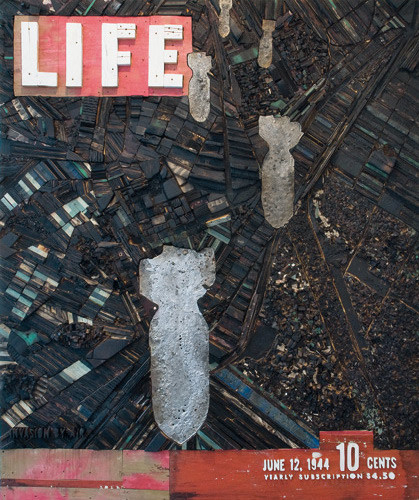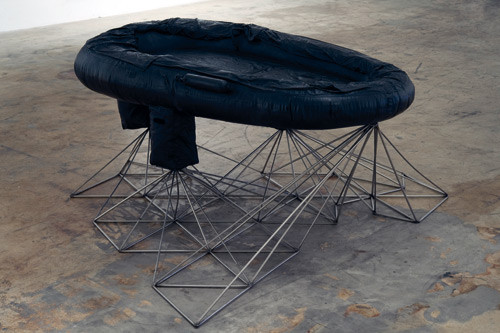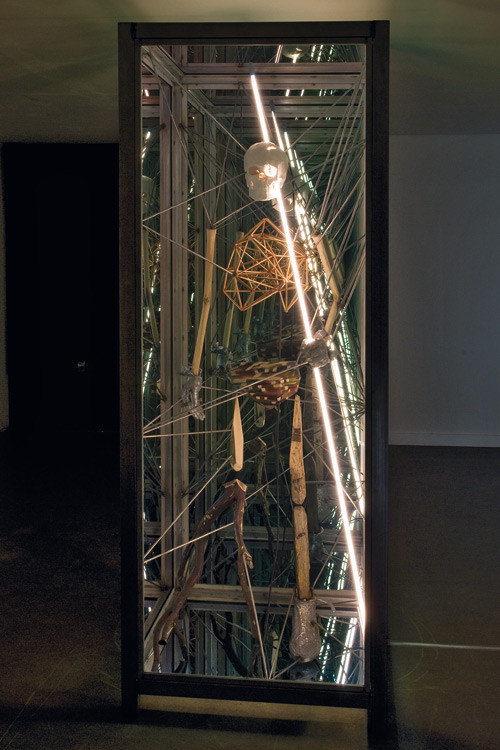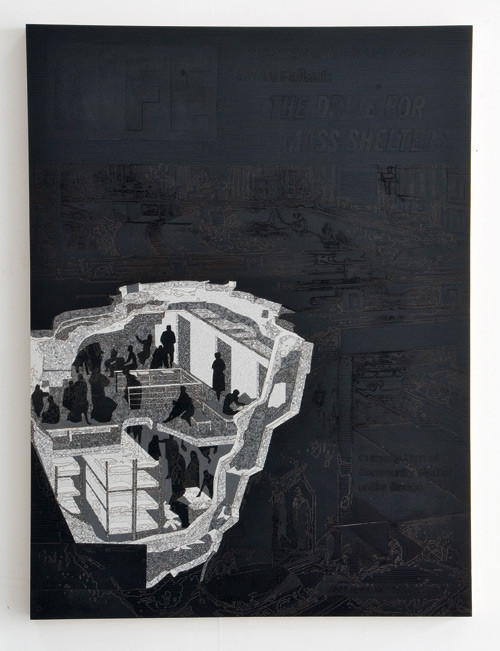Matthew Day Jackson
Published: August, 2010, ZOO MAGAZINE #28
Matthew Day Jackson is an American artist whose work is a mirror of our time. Whether through the medium of photography, video, sculpture or installations, his impressive art forces us to confront the acute and essential issues of our existence today. No wonder recognition, and the prices fetched by his work, is soaring. In his studio in New York, Jackson shares his vision of art, and the world around him.
Marta Gnyp: Have you ever wanted to become an astronaut?
Matthew Day Jackson: I feel as though being an artist is not so different from being an astronaut. I venture to places never seen, and report back on my experience. While on my journey into the unknown, I am protected by a suit made of all of my experiences, with an undergarment made of the culture that has created the person that I am. My hardened skin inscribed with the sum of everything protects me as I discover myself.
MG: You have often played with the Frankenstein aspect of our culture—the fear that scientific achievements that were intended to improve the human condition will turn finally against us. Is this for you a clear and present danger?
MDJ: Everything we do has the potential power of evoking beauty and horror. Humankind will continue to map the edge of human experience and the scientific discoveries along the way will bring new technologies. The government, and the companies that the government hires, develop new technologies based on advances in science for the purposes of hurting or killing people. This is a story that has been replayed numerous times in the later half of the 20th century, and into our current century.
MG: While watching and experiencing your works, I can feel your fascination for destruction and creation at the same time. You take on horrible events in history such as atomic bombings, but based on these narratives, you produced highly aesthetic objects — often, only the title gives the viewer a hint to the issue at stake. At the same time, you make works about the man conquering the cosmos. Is the excitement of destruction comparable to the excitement of creation and new discoveries?
MDJ: This is what I call ‘horriful.’ Beauty and horror are two sides of the same card, separated only by the thickness of the paper stock.
MG: Is Little Boy and Fat Man about beauty as well? Do you simply like the silhouette of the bomb?
MDJ: These objects were strictly utilitarian, aside from the way they were originally painted, and subsequently autographed. I know that I definitely do not like them. I think that I have always been drawn to the ‘horriful,’ and to try to capture it in a work of art would be wonderful. It would be a moment of balance, something I have never experienced.
MG: You seem to love big: big formats and the great narratives of our culture like the death, the nature and the (impossible) evolution of human kind. Your bombings, eruptions, frozen moments of the death, play with the idea of the sublime: there is fear but there is joy as well. Is this what makes your work so energetic?
MDJ: I think the attempt to bring many disparate forms, narratives and ideas together in a single work of art, and to make it legible creates a lot of tension. The work is a record of a moment, and although the energy has been spent, I love the idea that a work of art can tell of its journey from the day it is born recorded in its flesh. Also, in terms of scale, I am most interested in making things ‘life size.’ This could be thought in any permutation of what one would think of as ‘life size.’
MG: Do you believe in masterpieces? Do you believe that in our time we are still able to think in terms of a perfect artwork?
MDJ: Artworks are simply a record of where we have been, and although I do believe that there are masterworks in existence, the idea of a masterpiece makes me very uncomfortable. ‘Masterpiece’ suggests an end of learning for the maker, and a sense of laziness on the part of the viewer. I think every artwork is perfect. Whether it is good or bad is another story.
MG: Why did you start to make objects?
MDJ: My mom loves making stuff, as does my grandfather. My father loves motorcycles, as do my mom and grandfather, and I think of this as the rider/machine marriage being a love for participating/making. Motorcycles are almost strictly utilitarian, and the aesthetics are expressed in the structure of how it is made and in the finish of the surface. My stepgrandfather was a marine pilot, and my real grandfather was a paraplegic (injured during the Korean War and died when my father was 12) who made his own car controls so that he could drive, among many other things. He was a special person whom I never met. My great grandfather, great uncle, and my cousin have all built and raced the cars they built. In short, I come from a place where making stuff was not only a necessity but also a way to express your hopes and dreams.
MG: Your artworks look often like remade found objects. For me they are always perfectly controlled, as if you know exactly what effect they will have on the viewer. Do you ever use the element of chance?
MDJ: All we have is the opportunity to take a chance. I TRY to make everything exactly the way it needs to be to adhere to an image in my head. However, failure is always just around the corner. I liken this to when I skated, (I now only ride with my dog pulling), or when I ride my BMX bike in that I can envision the trick and I can see myself pull it off. In real time, I am only able to pull it off every once in a while. The low ratio of success to failure never keeps me from trying. When I am able to let go of the fear of getting hurt, or the fear of failing, this is when it gets good.
MG: Why do you so often show the skull in your work? This symbol of death, vanity and mortality was already being used in the Middle Ages, in the 17th century, in the 19th century. And in the past several years, we have seen a revival of the skull thanks to fashion designers and many contemporary artists. Can you explain the popularity of this symbol just now, and more specifically, your own fascination with this form?
MDJ: Any allusion to death in my work is NEVER a ‘memento mori.’ The image of Death is a ‘carpe diem.’ All we have is now. I think the skull will always be present in art and is but one of many ways our existence in the physical is expressed through form.
MG: Is it for you a challenge to use old iconic images in a new way? Is this a kind of emulation, the serious competition between you and other old and living artists?
MDJ: There is no competition—only the multi-faceted, cross-cultural, cross-gender, cross-race, cross-age, cross-time, etc, COLLABORATION. The purpose of this collaboration is to add to the boundless, sexless, colorless, ageless, and timeless language of ART.
MG: The way you use signs and symbols reminds me somehow of the search for a universal mythology, like American artists in the 40s such as Rothko, Pollock or Gottlieb. Do you intend to create your own symbols that could address the American psyche (if such a notion exists for you)?
MDJ: I am not so interested in symbols as I am in structure. I feel that my primary job is to create a unique formal structure unto myself and only in the service of my ideas, and the language I am trying to develop. I will borrow and steal forms and symbols, only to repurpose them (hopefully appropriately) in the work so that they have a new home. I try to leave the reference or found object close to its source so that its original meaning is an integral part of the larger conversation. I also believe that I own nothing, and that anything I do is open for others to destroy or build upon.
MG: Do you consider yourself as an American artist?
MDJ: “…in heart I’m an American artist, and I have no guilt. I seek pleasure. I seek the nerves under your skin. The narrow archway; the layers; the scroll of ancient lettuce. We worship the flaw, the belly, the belly, the mole on the belly of an exquisite whore. He spared the child and spoiled the rod. I have not sold myself to God.”—Patti Smith, Babelogue.
MG: Does digitalization and other new technical achievements have any influence on your art?
MDJ: No longer do we have to be subject to the mythology of linearity, and can absorb information from the cumulative sum of history. Also, because of the speed of this information, we can also absorb the cumulative—some of the ‘almost-now.’ It just happened. One thing does not lead to another, but rather EVERYTHING leads to another.
MG: Could the search for easy readable symbols be related to the globalization of our world and art?
MDJ: In my work, it is the only tangible way to express a belief in the generosity of the sharing of images and forms.
MG: You are using plenty of various materials and media like neon light, newspaper, formica, rubber, satellite images, burnt wood, posters, X-rays and many others. Do you think that this multitasking artist is typical for our time?
MDJ: I think artists have always been multitasking. Art is just the place that the experience is collected. Artists are artists all of the time, when brushing teeth, answering interview questions, or teaching their kids. So, I guess I think that artists behave no differently than they ever have. However there are more options open to us in terms of the technology that is available. This has changed what art looks like, but not the creative act.
MG: What matters in the art of our time?
MDJ: Everything, as it always has, matters.
DYMAXION BIOTRON, 2009, 221 × 83.8 × 83.8 CM, STAINLESS STEEL, PLASTIC, WOOD, LEAD, GOLD,
AXE HANDLES, NEON LIGHT
MG: You once said that the artist is a bit of a trickster and a delinquent in our Western society. At the same time, we still— consciously or unconsciously—cultivate the myth of the artist as a genius. The huge amounts of money that are being paid for many contemporary art works make some artists front-page celebrities in a very short time. Do you think that the status of the artist is nowadays more complex than ever?
MDJ: I think it was said more specifically in reference to being an American artist. We add to the myth of ourselves every day we get dressed and leave the house in the morning. Artists are not special, only necessary. Being an artist has nothing to do with making money. Also, I have never seen an artist on the front page of anything other than an art magazine. Maybe this happens elsewhere, but not here in the U.S. It is always complicated.
MG: During the Christie’s auction in February this year, one of your works was sold at more than half a million pounds, while the estimated price was around 30,000. What did this experience mean to you? Was it a miracle or a scandal? Did it somehow change your attitude toward the contemporary art world?
MDJ: No
MG: Why do you think the important collectors are investing in your art?
MDJ: I collect art because it makes me happy and is challenging. I would assume for them it is for the same reason.
MG: Do you think that your art is typical of our time, that it says more about today’s culture than art objects made by other artists?
MDJ: I am just one of many artists trying to make sense of the world we live in.
MG: Why did you make the photo Me, Dead at 35? Is this a ritual to keep the death outside? You wanted to experience mortality? Why the age at 35?
MDJ: My son was born when I was 35 and it made me realize that I had been living hypothetically. I mean this in the sense that I could say, think and make as I believed prior to my son’s birth, while nothing really held me to my words or work. Now I have to teach through action; I have to behave as I believe. Now it is time to try a theory. This made me realize that this is not a quick process and requires the passing of the person I was so that the person I am to become can take my place. I believe that life is syncopated with many mini-suicides, which is a way of cutting away the fat to get closer to the essence of who I am. I just finished Me, Dead at 36, as this is going to be a project in which I participate in various burial practices annually until I am dead. Each photo will be life size, and the final photo will be a life size photo of my ashes in a vessel of some sort, or perhaps being cryogenically frozen, and then smashed to pieces. Joseph Hung will take the photograph, or maybe my friend Sun Tek, or maybe Will Villalongo, as it depends on who wins the race (last man standing).
MG: Does your background play any role in producing art?
MDJ: It is everything and as each moment is subsumed into history, the accumulation is who I have become thus producing everything I would think of as Art.
MG: Have you had heroes who influenced your artistic and/or personal development or ideas that made you think differently? What were your ‘Aha’ moments?
MDJ: Many of these I will not share. However, here are some that I will. Larry Freemantle, who was my art teacher at Olympia High School; also, Denzil Hurley, who is a great painter and professor at the University of Washington; my grandfather, who can do anything and can argue with anyone (for fun); my mother, who can make anything; and my father, who is a dreamer; Laura Seymour, who is everything and sees many things I cannot. There is also my sister, who is more gifted than I, and Kristoffer Kollmer, who is my best friend, and brilliant. There are about a million artists and others but not enough time to list them all. ‘Aha’ moments happen every day. They are just little ones.
MG: The diversity of your subjects is great, but we could speak about a few strong lines of special attention from your side: big historical destructive narratives and scientific discoveries and their victims. What these themes have in common is probably the urge of the human being to create at any costs. Do you want to warn us against the powers of creation? Do you want to teach us something?
MDJ: Creativity is the essence of life and it is how we express our love for life. Creation and Death/Destruction are bedfellows; they are not married, but they do work together and they meet weekly at the motel to fuck the hell out of each other. I am learning and the more I learn, the more I realize that I have little to teach.
MG: Many works of yours are about the history and history-making. For example, your work Against the Mythology of Linearity questions in an intelligent and hilarious way the chronology of events, the logics of our linear way of interpretation of events. Would you like to correct the history?
MDJ: I think I always wish that there could be a Super Thucydides who could record all events in a way to create a way that we could see the ‘truth.’ This is impossible. I am more interested in the way we understand history as we are taught, and how our beliefs distort what we hear and read. The final lens is the little voice in the back of our head that is nearly impossible to hear, that really knows the truth about everything. It knows when we are full of crap, and the thing that makes us feel guilt. WAIT! I think I hear something! Never mind… By the way, I am glad you see humor. Few do.
MG: Once, you told me that you are like a contemporary variant of the fl‰neur, someone who walks through the world, observes it and makes objects that he sees like a mirror of himself. The mirror seems, in general, to be important in your work: you use it as a metaphor and you adopt it literally in your objects. How can your objects be a mirror for us?
MDJ: We see ourselves reflected in nearly anything, and if we look close enough, perhaps we can see our reflection in everything. The products we buy to adorn our bodies, the brands that encapsulate ‘who we are’ in a swoosh or jingle, or perhaps the haircut of a famous person we think would look good on ourselves; these moments I find really interesting. These are singular moments where it all comes together and we see ourselves perfectly. When I say that we see ourselves, it is more about what we choose to see, rather than what we actually look like. The perfection is when we adopt the thing in which we have seen ourselves. I am only interested in trying to make work that reflects who I am in an attempt to get to know myself better. I am very interested when other people start to see parts of themselves in the work. I think this is attributed to the fact that we share a great many attributes, but never the same combinations, or cumulative sum.
GIMME SHELTER 4, 1962, 2009, LASER CUT FORMICA, WOOD, 121.92 × 91.44 CM
MG: We are facing at this moment a huge production of artworks worldwide. Don’t you sometimes think that making objects is for many artists a waste of time?
MDJ: I don’t believe in wasted time. (Or) some think art in general is a waste of time.
MG: You once said that interconnectivity is important in our time. I wonder whether we are really interconnected or whether we are celebrating the postmodern idea that everything can coexist?
MDJ: Everything has always been interconnected and we have always ‘coexisted.’ We have just tried to develop ways of thinking and believing to alleviate the stress experienced from the burden of knowing we are all connected. These beliefs have alienated us from our neighbors, while we remain connected beneath or above our awareness. Through developments in science and art (among other things), the mythology of linearity will be forever fractured and riddled with detours. I have to believe that we are on a path toward the realization that we are all connected.


